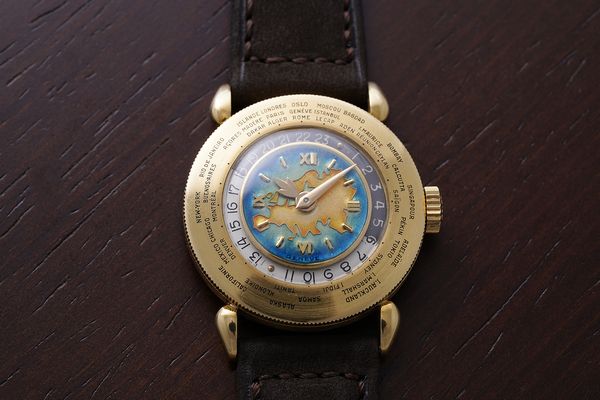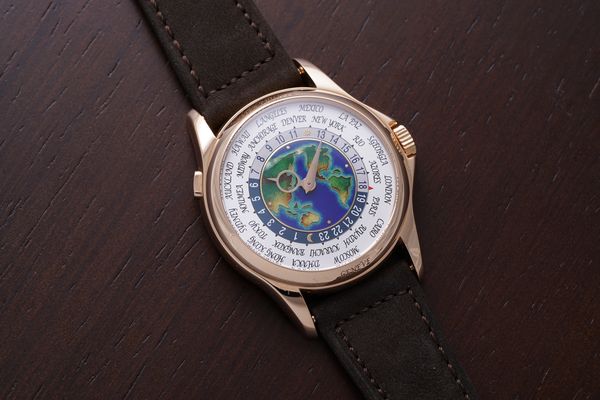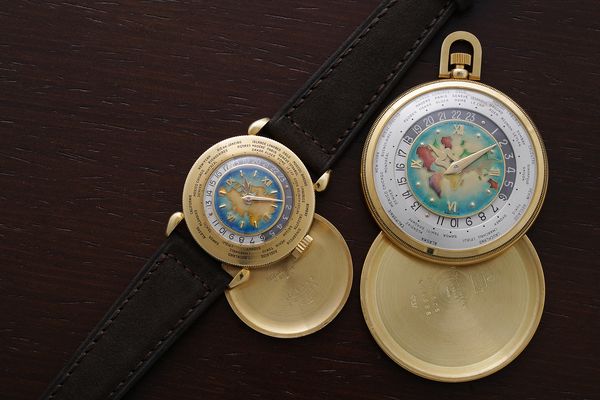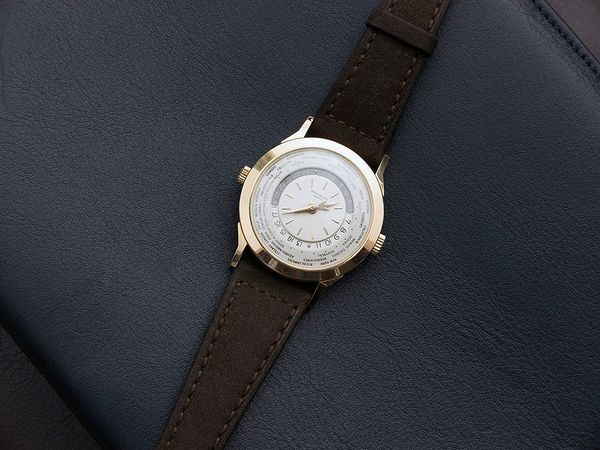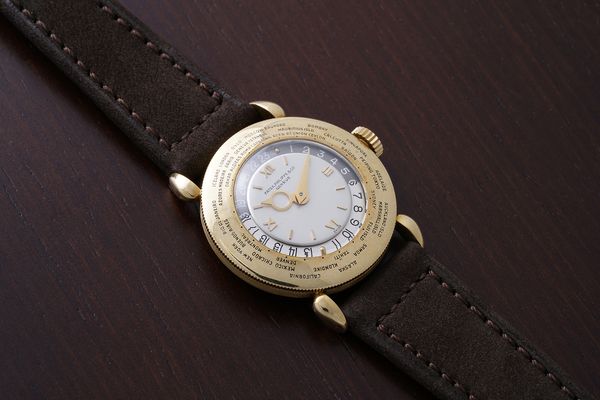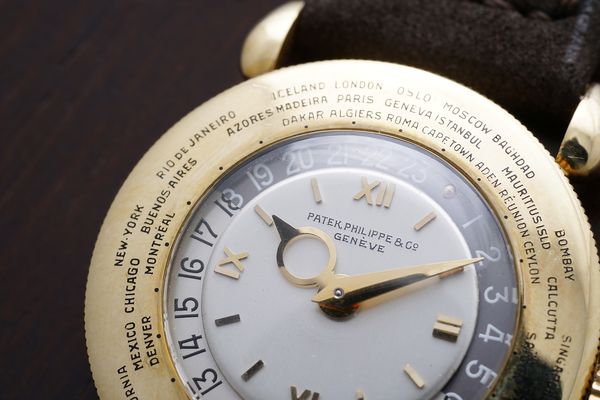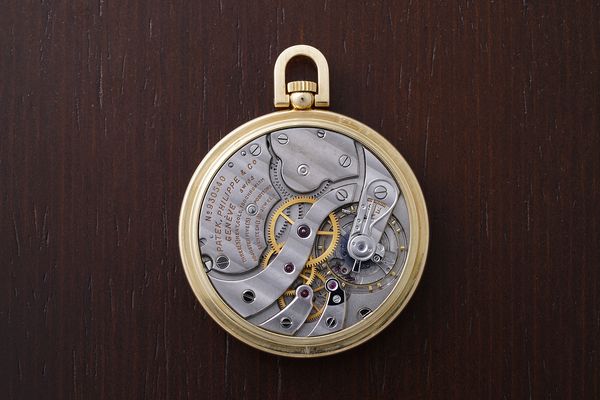- By Marcello De Marco
One of the privileges of working in the Watch Department of an auction house is not only to have access to remarkable timepieces, but also to be able to handle watches so rare that it is close to impossible to see them together at the same time. Such an opportunity arose during the preparation of our Spring 2018 sales, when a set of the first serially produced yellow gold Patek Philippe World Time watches, both in the standard and in the cloisonné enamel configuration, magically appeared together.
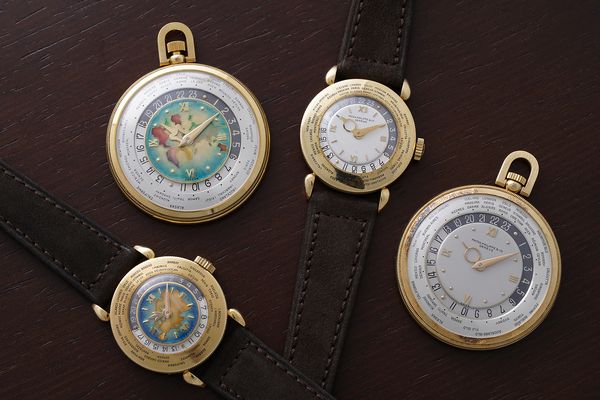
To celebrate this exceptional event, it seemed only fitting to take a look at the general context such wristwatches were born in, their influence on Patek Philippe’s production of complicated wristwatches, and finally, their rank in the pantheon of collectible watches. Today, Patek Philippe’s World Time pieces - both modern and vintage - are among the most coveted and iconic watches ever made by the company. But this wasn’t always the case. The manufacture found it difficult to find clients for these watches and consequently production was initially highly limited. Ironically, the extreme scarcity of these pieces later played a part in cementing their status as icons.
Even in current times, when the World Time complication is without a doubt classified among the most appreciated ones, Patek Philippe offers, out of a grand total of 191 models, seven World Time models: a guilloché-dial man’s model in white and pink gold, a lady’s guilloché version also in white and pink gold, a cloisonné-dial option in platinum, a World Time chronograph and a World Time minute repeater (launched this year). In other words, less than 5 percent of Patek Philippe current collection is dedicated to one of their most famous timepieces, and this is a major increase from a few years ago, when no chronograph nor repeating versions were available. This highlights how the World Time has been, and partly still is, a niche timepiece, which before being appreciated and becoming a legend of the field was considered, back in the 1940s, little more than an oddity with no real practical utility. While a major clash with today’s feelings about the complication, this sentiment is at least partially responsible for the creation of the fabled cloisonné World Time pieces, now true “Modigliani” of the watch world: incredibly rare, equally beautiful, and virtually impossible to acquire.
While the technical genesis of the World Time complication is well-known and described in virtually every auction catalogue featuring such a watch, the socio-economic conditions which prompted watchmakers to issue this complication are less scrutinized. It is often mentioned that the advent of jet-aviation and the ease of global movement were responsible for the development of the World Time watch. A plausible theory of course, but a debatable one too. Non-stop intercontinental commercial air travel goes back to 1929 (with the first commercial route being flown by a Zeppelin between Germany and New Jersey), but true intercontinental travel the way we intend it nowadays did not come to be until the 1950s, thus more than a decade after the introduction of the World Time. Furthermore, logically speaking, nothing in a jet flight (today as well as back then) demands for the passenger to simultaneously know the time in all 24 time zones, rather a Travel Time complication is in order - which will indeed be introduced by Patek Philippe in the late 1950s. While early long-range commercial flights propelled the common sentiment and imagination which were at least partial motivators for the development of the World Time complication, its true “raison d’etre” is most probably found in the development of information technology. The official telephone patent was deposed in the United States in 1877, but long distance calls remained a mirage until well into the 20th century, when in 1915 A. G. Bell placed the first transcontinental phone call. It is highly probable that being able to speak with any place on earth was the true reason behind the existence of the World Time: the need to properly time a call with the destination time, which could change for subsequent conversations, does effectively justify the complication.
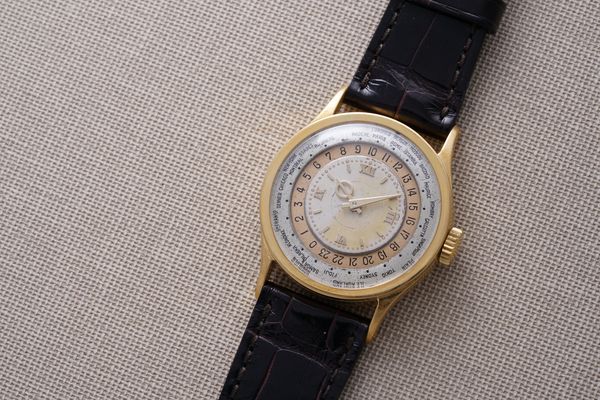
Indeed, the earliest examples of Patek Philippe World Time watches appear as unique pieces at the end of the 1930s, when telecommunication was becoming more easy and widespread. The first specimens are represented by a modified ref. 96 (officially reference 96 HU for Heures Universelles, a suffix present in all the vintage World Time references) and a rectangular wristwatch ref. 515, both delivered in 1937. However, neither watch allowed for the adjustment of the reference city, having a fixed city ring with Paris at 12 o’clock. Following these experiments, three references were developed: reference 1415, reference 1416 (very similar to 1415, but featuring bean-shaped lugs), and reference 542, featuring massive extended lugs and a smaller diameter of 27mm. Legend has it that these three references were produced side by side with extremely small output as a market test, which would eventually elect reference 1415 as the production model to appear in the catalogue starting from 1939.
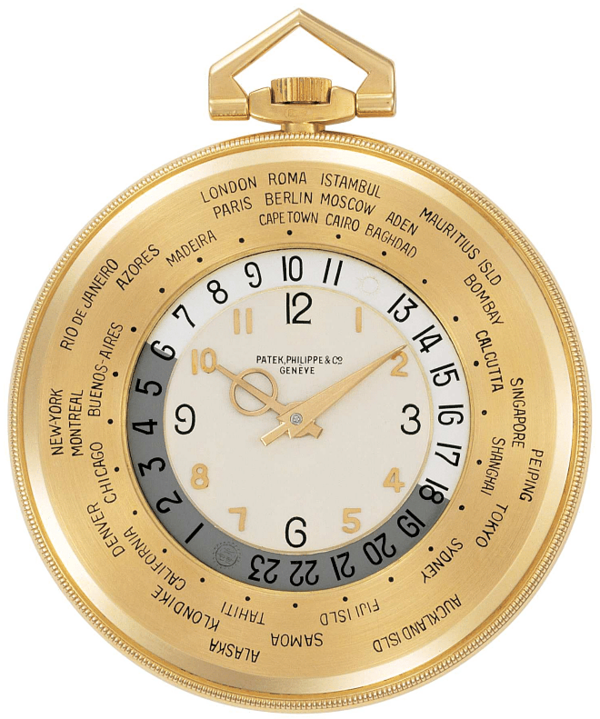
The pocket reference 605 seems to have a more linear history, directly appearing in the catalogue in the late 1930s, and evolving little over time. The other World Time pocket watch reference, currently residing in the Patek Philippe museum, is reference 1064 which, similarly to ref. 1415, features the city names engraved on a revolving metal bezel.
Watchmaking history, however, is often cruelly ironic: after the design experiments, after launching a new complication, after all the market research that had undoubtedly been made before the launch, the World Time complication, celebrated in period advertisements as indispensable “for men with international interests”, failed to be a success. There are multiple theories about why this happened, but no certainty. It was probably due to a combination of factors: the novel dial design may have been too complicated and difficult to read, and the effective utility of the complication was most probably lost on the manufacture’s clientèle. In any case, such a debacle prompted the realization of what are now considered among the most appealing and collectible watches of all time: the Cloisonné World Timers.
Enamel decor has widely used in watchmaking for centuries, with numerous timepieces from the 1800s displaying exquisite enameled cases and dials. However, the specific discipline of cloisonné enameling was not very much employed until the late 1940s: cloisonné enamel features extremely vivid colors, but cannot achieve the same level of detail as classic painted enamel. A shift in the common aesthetic sensibility, possibly fueled by the high amount of novel artistic trends, most of them abandoning the classic conception of figurative painting, might be the reason which prompted the (relative) diffusion of the cloisonné dials. Enormously costly and time-consuming to make, such dials began appearing as an alternative decoration to both reference 605 and 1415 (and later ref. 2523) in the late 1940s. Sometimes, such as most probably happened in the case of the cloisonné ref. 605 present in the Geneva sale, the unsold “standard” watch was eventually refurbished with a new cloisonné dial, in an attempt to finally sell it. However, the combination of exorbitant price and the somewhat unusual, possibly even “naive” style of the cloisonné dials did not help with the commercial fortune of the models, which were consequently made in extremely scarce numbers. It is estimated a total output of 115 pieces for reference 1415, and less than 100 pieces for reference 605.
In 1953, Patek Philippe completely modified the design of their World Time reference, bringing to the world the celebrated reference 2523 (and its later evolution 2523/1), distinguished by a larger size ( 36mm) and the two-crown case design. Even this last vintage effort was unsuccessful and the model was eventually discontinued in the 1960s, the last movements being delivered in 1965, marking the end of the vintage World Time Patek Philippe wristwatch references. Such a hiatus in production, rather than making the World Time wristwatch fade into oblivion, had a completely opposite effect: the few vintage World Time models were re-evaluated by the collecting community in light of their scarcity, technical and aesthetic appeal, and historical importance as the forerunners of a line of wristwatches which is now in extremely high demand. Eventually, Patek Philippe itself recognized the newfound interest of the market for this complication, and with the advent of the new millennium, a modern World Time reference was finally issued, after more than 30 years without a presence in the Patek Philippe lineup: reference 5110. This marked the resurgence of the model, which was soon updated with a larger case diameter, a cloisonné dial option obviously in homage to the vintage production, additional complications (chronograph, minute repeater, moon phases), lady’s versions, further case upgrades, and limited editions issued to celebrate special occurrences (Patek Philippe's New York exhibition, Patek Philippe's 175th Anniversary). In other words, the World Time complication is today truly one of the core specialties of Patek Philippe, and it all started with the vintage models, which is why these supremely exquisite and rare creations are now contended by the most discerning collectors of high-end vintage timepieces.
As mentioned before, the presence in the same season of both references (and in both configurations) is extremely unusual. Beyond the curiosity of this situation, it allows the beholder to properly gauge the impact of the enamel decor on the overall aesthetics of the watch, an exercise which can only be properly done with the watches side by side. When equipped with the standard silvered dials, both references emanate an extremely intense “1940s” vibe. The overall design is clean and without encumbering decorations - with one minor exception, the fancy teardrop lugs of ref. 1415 - fully embodying the utilitarian and nearly military design which was typical of watchmaking during wartime. These are extremely elegant and masculine timepieces designed without any compromise in terms of quality and absolutely embodying the concept of understated luxury Patek Philippe is famous for.
Once the same pieces don the hallowed cloisonné dial, however, the metamorphosis is nothing less than bewildering. The colorful, translucent center transforms the pieces in true works of art for the wrist. Even the size of the watches appears to be larger, obviously a psychological/optical illusion born from the more complicated dial. It should also be mentionned how the geographic theme of the maps is the perfect choice for a cloisonné World Time wristwatch: not only it is a strong reminder of the “geographic totality” of the complication, but furthermore the maps, with the countries neatly defined by boundaries, are an ideal theme to be executed with the cloisonné technique. It is no surprise that most of the modern World Time models with cloisonné dial happen to feature, today as it was back then, geographic maps.
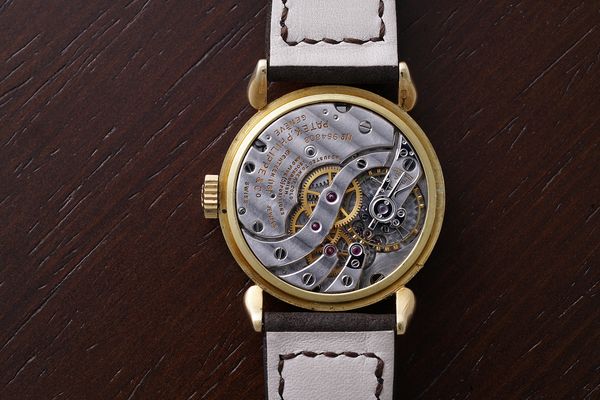
The presence of both references allows for a mechanical comparison of the calibres. The pocket reference is powered by a Cottier-modified cal. 17-170, one of the most appreciated pocket calibres of the time; the wrist model is instead powered by a modified cal. 12-120, also a top-end time only calibre. The similarities between the two movements are striking, especially in regard to the disposition of the bridges. If looking at them with the balance wheel at six, one notices that the lower half of both movements is essentially the same, featuring a long S-shaped bridge cutting the movement roughly in half and holding in place the first two wheels delivering energy from the mainspring to the escapement. Below it, at the left of the balance wheel, two additional bridges hold respectively the last powertrain wheel, and the escapement wheel.
The top halves of the movements present instead more differences: calibre 12-120 features a single plate covering virtually the entirety of this half of the movement. The pocket cal. 17-170 instead features two plates, one holding the mainspring barrel, the other one holding the winding wheel, a solution adopted due to the different location of the winding crown/stem. While very similar, the movements feature different performances, partly a consequence of their different size - even though it is possible to have two balance wheels of different size swing with the same frequency, given appropriately optimized hairsprings. The 17 lignes calibre vibrates at 18’000 vph, while the 12 lignes calibre ticks 19’800 times per hour.
The enamel Patek Philippe Ref. 605 and Ref. 1415 pocket watch and wristwatch are Lots 266 and 268 of the Geneva Watch Auction: SEVEN. The non-enamel versions are Lots 980 and 981 of the Hong Kong Watch Auction: SIX.
We would like to thank Patek Philippe and the Patek Philippe Museum for their invaluable assistance during the research for this article.

